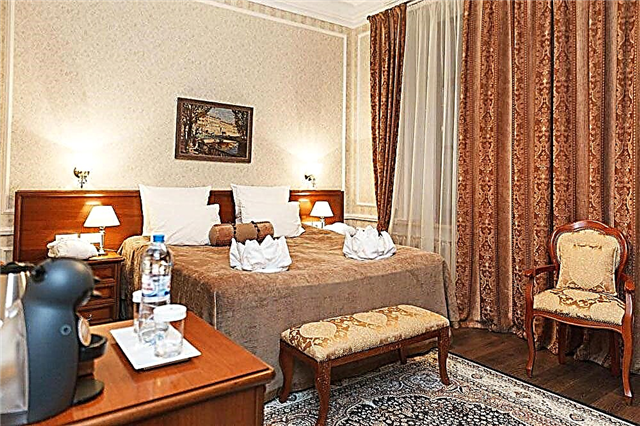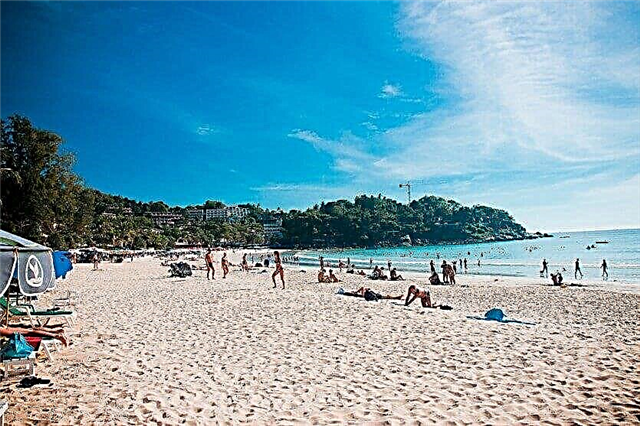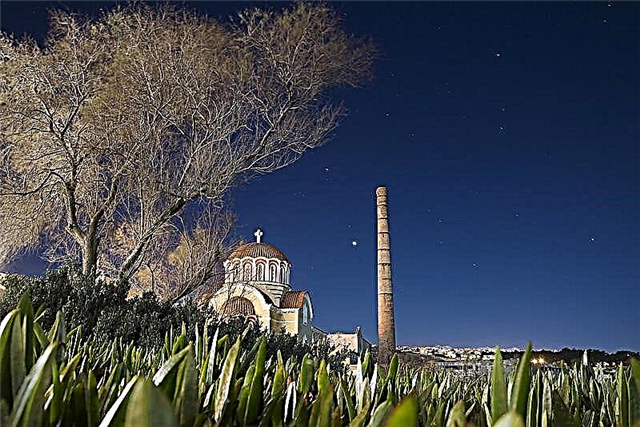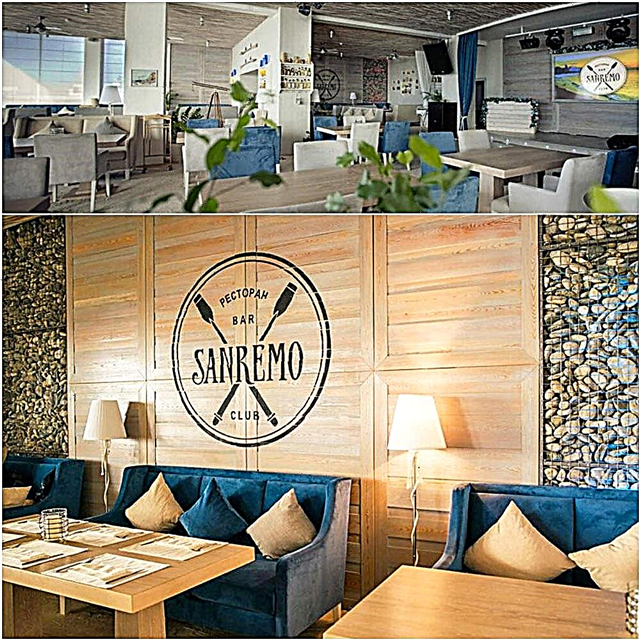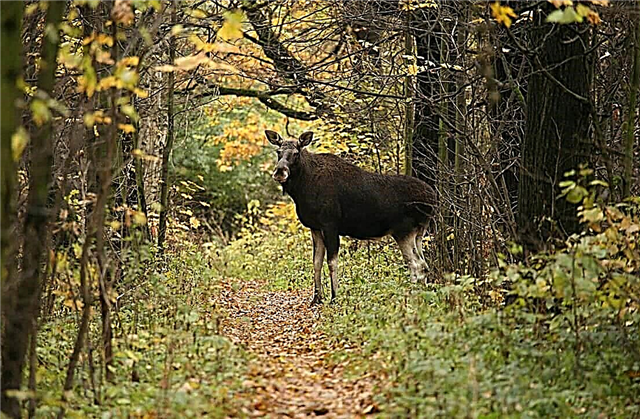National parks were invented by the Americans back in 1872. In Russia, the period of their formation is rather small, they began to be created only in the 80s of the XX century. Currently, there are 55 of them. Unlike the reserves in Russia, they are designed to perform not only nature conservation, but also recreational functions. More and more travelers today prefer ecotourism and choose places where they can merge with nature, get acquainted with the sights of the region, the history and culture of its peoples.
Ecotours often include elements of active tourism - cycling, river rafting, mountain trekking. Tourism and recreation in national parks provides an excellent opportunity for people tired of the noise of city life to take a break from the gas-polluted atmosphere, plunge into the world of wild nature, and restore the body's defenses.
The most famous national parks in Russia
National Park "Curonian Spit"
The park was founded in 1987. Only the southern part of the spit is located in the Kaliningrad region, the northern part is in Lithuania. Large forests are combined here with sand dunes. Interesting sights include the Dancing Forest, the Natural Museum, the Swan Lake, the Mueller and Efa dunes, and the birdwatching station. Among the archaeological sites are ancient settlements, fragments of fortifications, burial grounds, old fishing villages. There are many hotels and hostels.

Recommended: 20 interesting sights of the Curonian Spit.
Lena Pillars
Located in Yakutia, on the banks of the Lena. Received national status in 2018. The main asset is vertically elongated limestone rocks that stretch along the river for tens of kilometers. Their age is 400 thousand years. Rock paintings and runic letters were found on them. Water routes are popular, but there are also trails to the very tops of the cliffs, where there are observation decks. Another attraction of the park is the sand dunes in the desert - Tukulans.

Pribaikalsky
Located in the Irkutsk region, on the western shore of Lake Baikal. Founded in 1986, it has an area of 417 thousand hectares. Popular among tourists are the bays and bays of the Maloye More, a complex of salt lakes, majestic cliffs and karst caves, Dry Lake, which sometimes disappears, and the warmest Peschanaya Bay on Lake Baikal. The park is rich in archaeological sites such as ancient settlements, fragments of stone walls, rock paintings, wooden ritual pillars and burial grounds.

Zyuratkul
Located in the Chelyabinsk region near the town of Satka. The year of foundation - 1993. The main natural resources are mountain ranges and rivers, Lake Zyuratkul, huge outcrops of Bears, an artesian spring with a fountain, Elm grove, Makshantseva glade with thickets of lingonberries and blueberries. Climbing routes to Bolshoi Nurgush - the highest point of the region, Golaya Sopka and Lukash mountains - are popular with mountain tourism enthusiasts. The park is equipped with campgrounds and recreation centers.

Vodlozersky
It is located on the territory of Karelia and the Arkhangelsk region. Founded in 1991. Taiga forests are one of the largest in Eurasia. Many bogs with medicinal plants, berries and mosses. The pearl of the park is Lake Vodlozero, 400 km long. One of the best fishing spots in Karelia. You can take a walk on it on the old boat "Saint Elijah". There are many ancient Russian monuments - peasant huts, estates, chapels, the Ilyinsky churchyard complex.

Taganay
Located in the Chelyabinsk region, near the city of Zlatoust. Foundation date - 1991. For the splendor of the local landscapes, it is called Russian Switzerland. The main attractions are high mountain ranges, bizarre outlier rocks, a large placer Kamennaya River, ancient mineral mines, a complex of swamps. Popular among tourists are the Three Brothers rocks, May glades and the Valley of Fairy Tales - a short spruce forest with berry glades and outliers in the form of fairytale heroes.

Elk Island
Located in Moscow and the Moscow region, it was created in 1983. Since ancient times, the land has been used as royal hunting grounds. 80% of the territory is covered with forests. The Alekseevskaya grove, which is 250 years old, is worthy of attention. There are many reservoirs. From animals - wild boars, deer, moose. There are many historical monuments - barrows, ancient settlements, churches, fragments of palace buildings, an arched bridge of the 18th century. There are areas for recreation and sports. The Russian Life Museum was opened.

Khibiny
It is located on the Kola Peninsula in the Murmansk region. It received the status of a national park only at the beginning of 2018. The Khibiny Mountains located here are an open-air mineralogical museum. Many rare plants. It is planned to create the necessary conditions for the preservation of wild reindeer, since their number is decreasing every year. There are many sacred places on the territory of the Sami - the indigenous small people of the North.

Yugyd-va
One of the largest parks on the UNESCO list. Occupies an area of about 2 million hectares. Operates in Komi since 1994. Ural taiga combined with alpine meadows. There are many abandoned parking lots, places where Old Believers lived after the church reform in the country. There are several recreation centers. Tourists are offered to get acquainted with the life of nomadic reindeer herders, taste national dishes, ride reindeer. For lovers of mountain trekking - climbing the mountains of the People and Manaraga.

Alanya
Located in North Ossetia, on the slopes of the Caucasus. Founded in 1998. Most of it is covered with rocks, talus and glaciers. It is rich in historical monuments - ancient sites in caves, burial grounds, sanctuaries, fragments of medieval towers. Excursions to the mountain bog Chifandzar, a complex of waterfalls, to the Tan glacier are popular. Rare animals are the Caucasian leopard, the mountain goat, the Central Asian leopard. You can get to the park only by one road through the Akhsinta canyon.

Russian Arctic
The park includes the Northern Island and several islands of Novaya Zemlya, as well as a reserve on the territory of Franz Josef Land in the Arkhangelsk Territory. Foundation date - 2009. The main inhabitants are bowhead whales, seals, colonies of polar bears, narwhal, Atlantic walrus, numerous arctic birds. You can watch the Aurora Borealis. Cultural heritage sites are the sites of Willem Barents and Russian polar explorers. Visiting the park - on icebreakers and yachts.

Samarskaya Luka
It is located in the Samara region, in the area of the Volga bend around the picturesque Zhigulevsky mountains. Founded in 1984. It is rich in archaeological objects, among which the settlements of the Iron and Bronze Ages, ancient settlements of the Volga Bulgars, barrows, burial grounds, etc. Repin's house-museum was opened in the village of Shiryaevo, and an ethnographic museum in Bolshaya Ryazan. A network of tourist routes has been laid, the most famous of which is “Zhigulevskaya Around the World” by boats.

Sochi
Organized in 1983 on the territory of Greater Sochi. The main natural attractions are waterfalls, caves, canyons, mineral springs, the Sochi arboretum. There are more than a hundred historical and cultural monuments - the remains of fortresses and temples, ancient settlements, burial mounds, sites of primitive people, military obelisks, etc. The Monastyr settlement is a center for the revival of the population of the Central Asian leopard, included in the Red Book.

Russian North
It is located 120 km from Vologda. Year of creation - 1992. Rich in forests, as well as lakes and rivers belonging to the basins of the Volga and the White Sea. There are many architectural, archaeological and historical monuments - Mesolithic and Neolithic settlements, ancient monasteries and churches, historical villages, ancient trade and migration routes. There are more than 10 routes in the park, the most popular among tourists and pilgrims is through Mount Maura.

Alkhanay
The vicinity of Mount Alkhanay in Buryatia was declared a national park in 1999. It is believed that the outpost of Genghis Khan was on the mountain. For Buddhists, these are sacred lands, the Dalai Lama himself meditated here, temples are equipped in the caves. At the top of Alkhanay, the crater is filled with water, which is considered to be healing. In the vicinity of the mountain there are mud volcanoes and mineral springs. There are many archaeological sites - sites of ancient people, paintings on rocks, burial places of the Huns.

Kenozersky
Located in the Arkhangelsk region, 90 km from Kargopol. Organized in 1990. The main attraction is the picturesque lakes. The largest are Kenozero and Lakshmozero. Vegetation is represented by 534 species, especially valuable ones from the orchid family. There are more than a hundred historical and cultural monuments - ancient churches, peasant huts, hydraulic structures, worship crosses, chapels and holy groves. Water-walking routes and kayaking are popular.

Valdai
Occupies an area of 150 thousand hectares in the Novgorod region. Founded in 1990. 90% of the land belongs to forests. About 20 rivers and 70 lakes. There are many historical monuments - sites of ancient tribes, burial mounds, hills, ancient settlements, old estates, the best examples of church architecture. A hydroelectric power plant and a fishing plant are located - one of the first in the country. Hotels, recreation centers, about 80 tent camps are open for tourists. The park includes 151 settlements.

Crimean
The status of a national park was awarded in 2018. Occupies an area of 34 thousand hectares. Here are the highest mountain peaks of the Crimean ridge, vast forests, rivers, about 300 mountain springs, some of which are healing. One of the picturesque corners of the park is a trout farm. Also noteworthy are the Gazebo of the Winds, abandoned coal mines, a museum of partisan glory, a man's monastery, burials of ancient Taurus.

Sengileevskie mountains
Organized in 2017 on the territory of the Ulyanovsk region. The main natural resources are mountain ranges with a length of 22 km, a large area of mixed forests and steppes. Rare brook trout are found in the rivers. Another Red Book inhabitant of the park is the bobak marmot. According to legend, Stepan Razin's treasures are safely hidden in the Granny Ear Mountain. Among the archaeological sites is the ancient settlement of nomads Arbugim.

Tunkinsky
Organized on the territory of Buryatia, in the Tunkinskaya Valley, in 1991. The main natural treasures are lakes and volcanoes, chalk mountains, the "marble bottom" of the Kyngarga river, numerous mineral springs - arshan, near which sanatoriums are built. Also worthy of attention is a Buryat settlement, an ethnographic museum, and a Buddhist temple. Popular routes run through the Munku-Sardyk and Altan-Mundarga mountains, revered by the locals.

Bashkiria
92 thousand hectares of majestic forests, deep caves, mountain rivers and streams in the southeast of Bashkiria, on the slopes of the South Urals. Year of formation - 1986. Interesting natural objects - a 35-meter karst bridge formed by an underground river, caves and tunnels of the Kutuk tract with numerous underground passages and halls, stalactites and cave pearls, Bear glade with thickets of a meter-long relict onion. Sanatoriums and recreation centers have been built on the banks of the Nugush reservoir.

Beringia
It is located in the east of Chukotka, in the vicinity of the Bering Strait. Received federal status in 2013. It is famous for its bird colonies - about 200 species of birds, and rookeries of sea pinnipeds. Archaeological sites are represented by Paleolithic sites, structures made of whale bones, products made of walrus tusks. The population is Chukchi and Eskimos. Tourists are offered visits to national holidays and the opportunity to purchase bone souvenirs.

Oryol Polesie
It is located on the territory of two districts of the Oryol region, founded in 1994. The largest forests in the region, about 300 species of animals, more than 800 species of plants. A European bison is bred, and an open-air zoo with camels, ostriches, mouflons, bison, etc. is organized. The Turgenev Museum is open, his "Notes of a Hunter" is dedicated to the Oryol Polesie. There are several archaeological sites, a route has been developed to the places of military events.

Paanajärvi
Year of foundation - 1992. Located in the north of Karelia, on the border with Finland. 104 thousand hectares of wildlife and not a single settlement. A small but very deep lake Paanajärvi with an abundance of fish is the pearl of the park. Red rocks, stepped waterfalls, rivers with many rapids, more than a hundred lakes are no less delightful. Popular routes are through the mountains Nuorunen and Kivakka, covered with silvery reindeer moss. You can only get there by car.

Bikin
It is located in the Primorsky Territory, in the Bikin River basin. Organized in 2015, it is included in the UNESCO heritage list. The main tasks are to preserve the virgin forests of the Ussuri taiga and the Amur tiger population. On the territory of the park, mostly in the village of Krasny Yar, there are small indigenous peoples of Russia - the Nanai and Udege. To get acquainted with their way of life, traditions and crafts, special ethno tours are organized.

Buzuluk forest
It is located in a deep basin on the territory of two regions - Orenburg and Samara. This site is approximately 6-7 thousand years old. It received the status of a national park in 2007. More than 2/3 of the forest area is occupied by pine trees. Some are over 300 years old. 10 hectares of the park is occupied by an arboretum. The Borovoy Experimental Forest Station building is a monument of wooden architecture. There are many reservoirs, fishing is allowed. There is an excursion to the apiary.

Leopard land
Located in the Primorsky Territory. Created in 2012, the main goal is to protect the Far Eastern leopard, the smallest feline in the world. Other inhabitants include spotted deer, red deer, Amur tigers, and the Ussuri marten. The main route of the park offers acquaintance with the wild nature of the region, the life of predators, places of military events. The first ecological tunnel was built here for the safe movement of animals.

Kislovodsk
Located in the southern part of the city in the Olkhovka river valley. National status - since 2017. Among the interesting natural objects are the Valley of Roses, Blue, Red and Gray stones, Narzan Gallery, Pine Hill, Mirror Pond. There are also many original architectural structures - the Lermontov area, the Pushkin monument, the Temple of Air, the flower calendar, the Red Sun pavilion. There are several paths for therapeutic and recreational walking along the park.

Zabaikalsky
It is located in Buryatia, in the Baikal region. Created in 1986. It includes natural objects - the Svyatoy Nos peninsula with grotto caves, the Ushkany Islands with huge seals rookeries, the Barguzinsky Bay with a 26-kilometer sandy beach, the Chivyrkuisky Bay islands with bird colonies, several salt lakes. There are also historical sites - ancient sites of nomads, settlements, fragments of an ancient irrigation system. The nearest village is Ust-Barguzin.

Ladoga skerries
A picturesque natural complex of large and small rocky islands on Ladoga, in the Republic of Karelia. This skerry landscape has no analogues in Europe. The area is 122 thousand hectares. The park was created in 2017. The habitat of the Red Book Ladoga ringed seal. Numerous monuments of federal significance - ancient sites, fortified settlements, burial grounds of the 6th-4th centuries. BC e. Also of interest are the buildings of the 19th century in the historical part of the city of Sortavala.

Meschera
Located in the Vladimir region, in the vicinity of Gus-Khrustalny. Founded in 1992. On the territory there is a large tourist center, a nature museum, an open-air museum of local lore with Russian huts and old buildings, where national holidays and animation programs are held.Short and multi-day routes along ecological trails are popular. For children, a Fairy Tale Trail has been created with the most famous and beloved fairy tale characters.

Nechkinsky
Created in Udmurtia, on the Kama River, in the vicinity of the Votkinsk reservoir. Natural resources - taiga and mixed forests, forest-steppe, lakes and springs with clear water. Specially protected natural monuments - a complex of peat bogs and the Sidorovy Gory, where the remains of a dinosaur were found. Among the archaeological sites are the sites of the ancient people of the Neolithic, fortifications of the Iron Age period. In the village of Nechkino there is a large sports and tourist center.

Lower Kama
It is located in Tatarstan, in the lower reaches of the Kama. It is rich in forests and a chain of forest lakes, large areas of floodplain meadows. The two most popular routes are along the places where the famous paintings of the artist Shishkin were created and along the three rivers of the park by kayaks. Archaeological sights - Elabuga settlement with fragments of an ancient fortress, mysterious Devil's settlement, ancient sites and burial grounds of the VIII-III centuries. BC.

Onega Pomorie
It is located in the Arkhangelsk region, on the territory of the Onega Peninsula. Founded in 2013. The main treasures are taiga wild forests, numerous bird lands, rare sea pinnipeds. It is also home to a valuable deep-sea mollusk - European pearl mussel. Historical and archaeological sites deserve attention - parking lots and stone structures, created 7000 years ago, the remains of the Solovetsky Kremlin, the 3rd lighthouse of the 19th century, fragments of an agar plant.

Pleshcheyevo lake
Park on the coast of Lake Pleshcheevo, in the Yaroslavl region. Created in 1988. On its territory is the city of Pereslavl-Zalessky. Among the historical and natural monuments are the Kleshchino settlement, the ancient shrine Blue Stone, the place on Mount Gremyach, where the first flotilla of Peter I was built, the healing springs of the Great Martyr Varvara, Prishvin's house, and the arboretum. The lake is popular with windsurfing and kiting fans. Hotels and recreation centers were built around it.

Elbrus
Created in Kabardino-Balkaria, at the foot of Elbrus, in 1986. It is popular among fans of skiing, mountaineering, alpine cycling. There are 6 villages on the territory, more than 20 recreational centers have been opened. The most popular tourist routes are to the mountains Elbrus, Cheget, Gud-mountain, to the Narzan Valley. Also noteworthy are waterfalls, the Valley of stone "castles", stone "mushrooms", lava sculptures.

Saylyugemsky
Located in the Altai Republic. Year of creation - 2010. The pride of the park is more than a dozen snow leopards, the most numerous population of the argali ram - argali and quite rare brown bears of light color. The local population, the Telengit Altai, breed camels and yaks, and are engaged in ancient crafts. There are several local history museums. Among the monuments of archeology there is an ancient observatory, barrow complexes, runes and rock paintings.

Call of the tiger
Year of foundation - 2007. Located in the southeast of Primorsky Krai. 96% of the territory is covered with forests. Habitat of the Red Book Amur tigers, forest Far Eastern cat and 50 more species of mammals. You can meet the rarest bird in the country - the fish owl. Popular routes are climbing the highest mountain of the region, Oblachnaya, as well as Snezhnaya, Brata, Sestra, and in the valley of the Milogradovka river, to mountain waterfalls. The nearest villages are Lazo and Chuguevka.

Smolenskoe Poozerie
The territory of the park in the north-west of the Smolensk region is 80% covered with forests, but its main pride is more than three dozen picturesque and very ancient lakes. Sapsho is the largest and most beautiful of them; on its shore there is a sanatorium, a museum-estate of Przhevalsky, and several holy springs. The park includes more than a hundred archaeological sites - settlements, mounds, sites of the Neolithic times, traces of the ancient city of Verzhavsk, founded in the XII century.

Shantar Islands
The archipelago in the Sea of Okhotsk has had the status of a national park since 2013. Almost deserted, the main inhabitants are whales, killer whales, pinnipeds, seabirds, bears. There are large salmon spawning grounds in the rivers, and a very rare mykizha fish is found. There are deposits of jasper, marble, quartzite, rhodonite. There is a meteorological station on the territory. The nearest settlements Chumikan and Tugur are 100 km away. Tours are organized from Khabarovsk and Komsomolsk-on-Amur.


